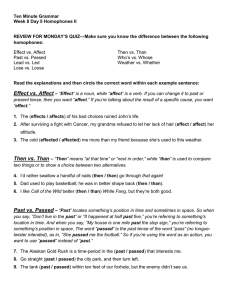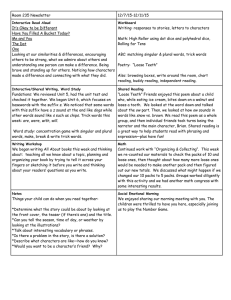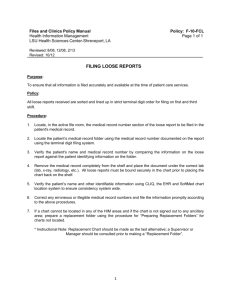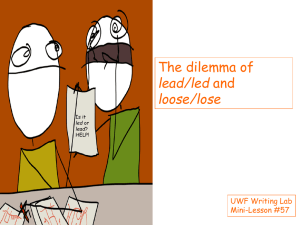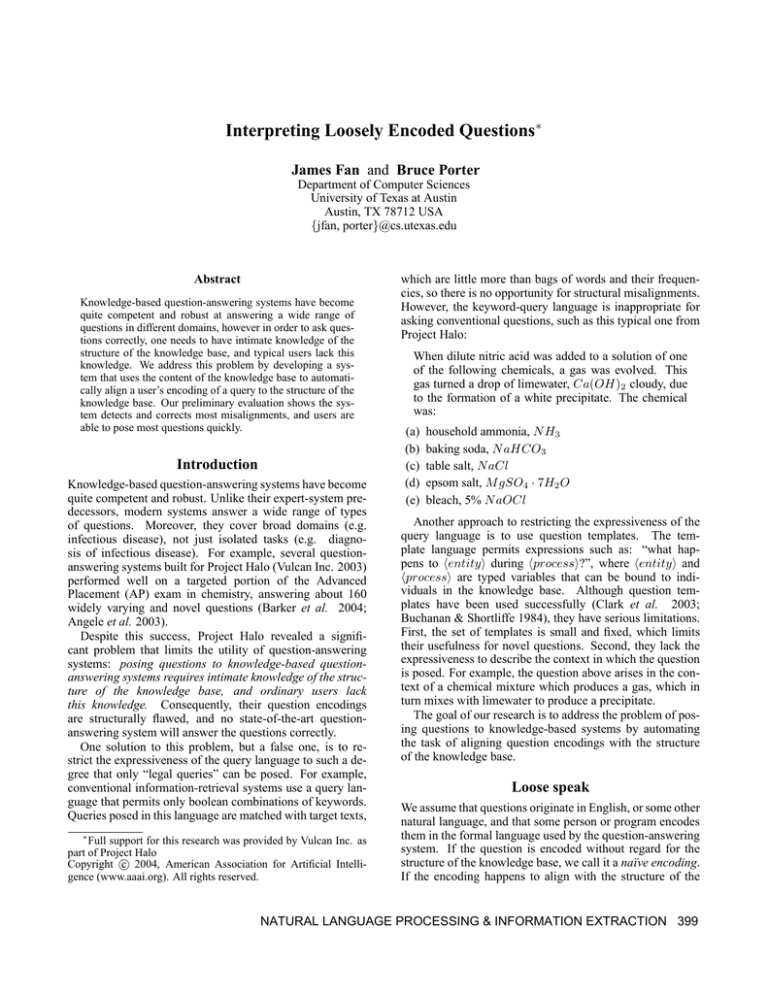
Interpreting Loosely Encoded Questions∗
James Fan and Bruce Porter
Department of Computer Sciences
University of Texas at Austin
Austin, TX 78712 USA
{jfan, porter}@cs.utexas.edu
Abstract
Knowledge-based question-answering systems have become
quite competent and robust at answering a wide range of
questions in different domains, however in order to ask questions correctly, one needs to have intimate knowledge of the
structure of the knowledge base, and typical users lack this
knowledge. We address this problem by developing a system that uses the content of the knowledge base to automatically align a user’s encoding of a query to the structure of the
knowledge base. Our preliminary evaluation shows the system detects and corrects most misalignments, and users are
able to pose most questions quickly.
Introduction
Knowledge-based question-answering systems have become
quite competent and robust. Unlike their expert-system predecessors, modern systems answer a wide range of types
of questions. Moreover, they cover broad domains (e.g.
infectious disease), not just isolated tasks (e.g. diagnosis of infectious disease). For example, several questionanswering systems built for Project Halo (Vulcan Inc. 2003)
performed well on a targeted portion of the Advanced
Placement (AP) exam in chemistry, answering about 160
widely varying and novel questions (Barker et al. 2004;
Angele et al. 2003).
Despite this success, Project Halo revealed a significant problem that limits the utility of question-answering
systems: posing questions to knowledge-based questionanswering systems requires intimate knowledge of the structure of the knowledge base, and ordinary users lack
this knowledge. Consequently, their question encodings
are structurally flawed, and no state-of-the-art questionanswering system will answer the questions correctly.
One solution to this problem, but a false one, is to restrict the expressiveness of the query language to such a degree that only “legal queries” can be posed. For example,
conventional information-retrieval systems use a query language that permits only boolean combinations of keywords.
Queries posed in this language are matched with target texts,
∗
Full support for this research was provided by Vulcan Inc. as
part of Project Halo
c 2004, American Association for Artificial IntelliCopyright gence (www.aaai.org). All rights reserved.
which are little more than bags of words and their frequencies, so there is no opportunity for structural misalignments.
However, the keyword-query language is inappropriate for
asking conventional questions, such as this typical one from
Project Halo:
When dilute nitric acid was added to a solution of one
of the following chemicals, a gas was evolved. This
gas turned a drop of limewater, Ca(OH)2 cloudy, due
to the formation of a white precipitate. The chemical
was:
(a)
(b)
(c)
(d)
(e)
household ammonia, N H3
baking soda, N aHCO3
table salt, N aCl
epsom salt, M gSO4 · 7H2 O
bleach, 5% N aOCl
Another approach to restricting the expressiveness of the
query language is to use question templates. The template language permits expressions such as: “what happens to hentityi during hprocessi?”, where hentityi and
hprocessi are typed variables that can be bound to individuals in the knowledge base. Although question templates have been used successfully (Clark et al. 2003;
Buchanan & Shortliffe 1984), they have serious limitations.
First, the set of templates is small and fixed, which limits
their usefulness for novel questions. Second, they lack the
expressiveness to describe the context in which the question
is posed. For example, the question above arises in the context of a chemical mixture which produces a gas, which in
turn mixes with limewater to produce a precipitate.
The goal of our research is to address the problem of posing questions to knowledge-based systems by automating
the task of aligning question encodings with the structure
of the knowledge base.
Loose speak
We assume that questions originate in English, or some other
natural language, and that some person or program encodes
them in the formal language used by the question-answering
system. If the question is encoded without regard for the
structure of the knowledge base, we call it a naı̈ve encoding.
If the encoding happens to align with the structure of the
NATURAL LANGUAGE PROCESSING & INFORMATION EXTRACTION 399
No loose speak
Metonymy
Causal factor
Role
Aggregate
Too generic
Noun compounds
Pilot (N = 43)
2.3%
25.0%
45.5%
9.1%
77.3%
34.1%
22.7%
Final (N = 107)
0.0%
10.8%
23.5%
7.8%
87.3%
40.2%
29.4%
Table 1: Types of loose speak, and their frequencies, encountered in two sets of AP-like questions from Project
Halo. The pilot set contains 43 questions in total; the final set contains 107 questions in total. The first row shows
the percentage of questions that contained no loose speak –
i.e. for which a naı̈ve encoding was correct. Note that the
sum of the frequencies exceeds 100% because each question
may contain multiple occurrences of loose speak.
knowledge base, then it is a correct encoding of the question. If, on the other hand, any part of the encoding fails to
align with the knowledge base, we call that part loose speak,
in reference to the imprecise way that people form English
expressions.
The term “loose speak” is not meant to be pejorative.
To the contrary, question encodings that contain loose
speak are often literal translations from the original English
expressions– i.e. the form of questions we should expect
from typical users. The goal of our project is to improve
knowledge-based question-answering systems by developing ways to automate the interpretation of loose speak to
produce correct encodings of questions.
conductivity
Aqueous−Solution
base
HCl
Figure 1: An example of loose speak from the Project Halo
question set: “Is a water solution of HCl conductive?”. The
“?” in the figure indicates an query. With respect to the
chemistry knowledge base, this encoding contains two occurrences of loose speak. First, it contains aggregate loose
speak: a HCl is a molecule, and a single molecule does
not act as the solute of a solution because it does not have
properties such as concentration. The HCl in the encoding should be replaced by a Chemical whose basic structural unit is a HCl molecule. Second, it contains metonymy
loose speak: the conductivity property belongs to solutes
instead of solutions because it is the solutes that determine
the conductivity of a solution. The query “the conductivity of Aqueous-Solution” should be placed on the base of
the Aqueous-Solution instead. Figure ?? shows the correct
encoding of this query.
•
Types of loose speak and their frequencies
Misalignments between queries and the knowledge bases to
which they are posed are common and unavoidable because
knowledge bases, like many engineered systems, are full of
idiosyncratic design decisions. Since a naı̈ve encoding may
differ from a correct encoding in many ways, developing
and testing a loose-speak interpreter appears to be a daunting
task.
However, we have found that occurrences of loose speak
cluster into a small set of categories that share interpretation strategies. This section describes a study in which we
analyzed two sets of questions from Project Halo. All the
questions were given in English. We built naı̈ve encodings
for the questions and matched the encodings with the structure of the chemistry knowledge base built for Project Halo
(Barker et al. 2004). Here are the types of loose speak we
encountered:
• Metonymy: referring to an entity or event (the referent)
by one of its features or attributes (the metonym).
The metonym is related to the referent through a
restricted set of relations; a commonly used list of
metonymic relations is compiled by (Lakoff & Johnson
1980). It has the following relations: PART-FORWHOLE, PRODUCER-FOR-PRODUCT, OBJECTFOR-USER,
CONTROLLER-FOR-CONTROLLED,
400
?
•
•
•
•
INSTITUTION-FOR-PEOPLE-RESPONSIBLE,
PLACE-FOR-INSTITUTION
and
PLACE-FOREVENT.
Figure 1 contains an example of metonymy: a property
(conductivity), which pertains to a part (solutes), is ascribed to the whole (the aqueous solution).
Causal factor: referring to a result by one of its causes.
For example, a chemistry question might refer implicitly
to a chemical reaction by mentioning only the “mix” or
“add” event that causes the reaction.
Aggregate: referring to an aggregate by one of its members, or vice-versa. For example, in figure 1, HCl must
refer to a set of molecules, i.e. a chemical, not an individual HCl molecule, because a solution of HCl should
contain more than one HCl molecule. Although this
type of loose speak is similar to PART-FOR-WHOLE
metonymy, it differs in terms of the partonomy types to
which it applies. The PART-FOR-WHOLE metonymic
relation applies to heterogeneous sets (e.g. an entity can
have different types of parts, such as the various parts of
a car), but the aggregate relation applies to homogeneous
sets (e.g. each individual in the set is a basic unit of the
set, such as a single soldier in an army).
Role: referring to an entity by a role played by that entity,
or vice-versa(Fan et al. 2001). For example, a Bronsted
acid is a role played by chemicals in the context of reactions, but is often used loosely, omitting the context as in:
“these chemicals are Bronsted acids”.
Overly generic concept: referring to a specific concept
or instance by the generic class to which it belongs. For
example, a “reaction” is used to refer to an “equilibrium
reaction”.
Noun compounds: referring to the implicit relation be-
NATURAL LANGUAGE PROCESSING & INFORMATION EXTRACTION
Given a triple of the form <C1, r, C2>:
RESULT = nil
If domain_violation (C1, r) then
RESULT = search_head(<C1,r,C2>)
else if range_violation (C2, r) then
RESULT = search_tail(<C1,r,C2>)
else if not(resemblace_test (<C1, r, C2>)) then
RESULT = search_head(<C1,r,C2>)
If not (RESULT) then
end if
RESULT = search_tail(<C1,r,C2>)
end if
end if
end if
paired. The order of traversal does not matter because (other
than “overly generic concept” type of loose speak) the interpreter does not alter the original head or tail. Rather, the
interpretation of each edge is a series of connecting edges,
and the interpretation of one edge does not affect the interpretation of other edges. For “overly generic concept” type
of loose speak, the interpreter replaces the head or the tail of
an edge with a more specific class, and a simple backtracking algorithm is used in case the more specific class conflicts
with edges connected to the original edge.
Test & repair
During the traversal of the conceptual graph encoding the
question, each edge is tested and repaired. Figure 2 shows
the algorithm for the test and repair procedure. The test determines whether the edge contains loose speak. Because
the correct encoding is unknown, the test uses this heuristic:
If RESULT then
Return RESULT
else
Return <C1, r, C2>
end if
Figure 2: The search algorithm used to interpret one triple.
The algorithm detects loose speak by checking the domain,
range constraints and checking to see if the input expression
is similar to any existing knowledge. If loose speak is found,
then it calls the two search routine to search for encodings
similar to the input, and it returns the search result if any is
found, or the original input if nothing else is found.
tween a pair of nouns by using just the noun phrase consisting of the two nouns. For example, “zinc metal” refers
to metal composed of zinc. Noun compounds are a type
of loose speak because they omit the semantic relation between the head noun and its modifier(s), and this omission
must be rectified before the reference is clear.
Table 1 reports the results of our study. We can draw several conclusions from this study. First, loose speak is ubiquitous, occurring in virtually every question we analyzed. Second, loose speak concentrates on a small number of types.
We found common types of loose speak, some of which occur as frequently as 87% of the time.
Interpreting loose speak
Algorithm Overview
The input to our loose-speak interpreter is a question encoding, which may or may not contain loose
speak, and the output is the correct encoding of
the question.
The question encoding is a conceptual graph consisting of a set of labeled edges of the
form: hConceptClass, relation, F illerClassi. We call
ConceptClass the head and F illerClass the tail. Queries
are encoded as a special type of edge in which the tail is
unknown (denoted: “?”). Figure 1 is an example of such
encoding.
The interpreter makes multiple passes through the set of
edges. Each pass is equivalent to traversing the graph. During each pass, the interpreter applies a “test & repair” function to every edge. The interpreter stops when a pass is completed in which all the edges pass the test, so none is re-
If the edge violates structural constraints, then it must
contain loose speak (because correct encodings are
consistent with the structure of the knowledge base).
The only structural constraints used by the interpreter are
based on the domain and range of the relation in an edge.
Specifically, for an edge hC1 , r, C2 i, the domain of r must
subsume C1 , and the range of r must subsume C2 .
Although the constraint check returns many true positive cases, it also may return many false negatives. The
constraint check is complemented by a resemblance check.
The resemblance check is based on the hypothesis that if
the input does not resemble any existing knowledge, then
it may contain loose speak because studies have shown that
“one frequently repeats similar versions of general theories”
(Clark, Thompson, & Porter 2000). Even though the knowledge resemblance test may return many false positives, it
returns many true negatives as well.
The resemblance test, applied to an edge, is implemented
as follows. If the edge represents a query (i.e. the tail of the
edge is “?”), the edge passes the test only if the knowledge
base can compute one or more fillers for the tail. (This is
the basic question-answering function of a knowledge base.)
Otherwise, the edge hHeadq , r, T ailq i passes the test only
if the knowledge base contains an edge hHeadkb , r, T ailkb i,
such that Headkb subsumes or is subsumed by Headq and
T ailkb subsumes or is subsumed by T ailq .
After loose speak has been detected in a edge, it is
interpreted by searching the knowledge base for similar
edges. The search is conducted by two breadth-first procedures: search_head and search_tail. Given the
edge hC1 , r, C2 i, the search_head function starts at C1 ,
traverses all semantic relations, such as “has-part”, “agent”
and “subclasses”, and stops when a suitable instance is
found. An instance, C3 , is suitable if the triple hC3 , r, C2 i
does not contain loose speak. The successful search path is
returned as the interpretation for the input.
To avoid unintended interpretations, the semantic relations do not include “superclasses” relation. If both “subclasses” and “superclasses” are included in the search path,
then any concept can be found from C1 by climbing up and
NATURAL LANGUAGE PROCESSING & INFORMATION EXTRACTION 401
Aqueous−Solution
?
Solution
base
conductivity
subclass−of
Chemical
Chemical
base
Aqueous−Solution
has−basic−structural−unit
has−basic−structural−unit
Chemical−Entity
volume
Volume−Value
Halo KB
Figure 3: The application of “search-head” function on the
edge h Aqueous-Solution, base, HCl i. The function
is called because this edge does not resemble any existing
path in the knowledge base. The loose speak is resolved by
breadth-first search from Aqueous-Solution, along all the
semantic relations such as volume, base, subclasses, until
a HCl or a superclass or subclass of HCl, is found. In this
example, the search stops at depth 2, and returns the new
edge h Aqueous-Solution, base, h Chemical, has-basicstructural-unit, HCl i i because HCl is a superclass of
Chemical-Entity. The bold line in the above figure shows
how the result is found.
HCl
Figure 4: The interpretation of the query in Figure 1 in the
context of the chemistry knowledge base built for Project
Halo. Notice that HCl is replaced by Chemical, and
the conductivity query has been moved from AqueousSolution to the base of Aqueous-Solution to conform to
the structure of the knowledge base.
This algorithm applies to all types of loose
speak, even noun compounds.
A noun compound
is represented as an unlabeled edge of the form:
hM odif ierClass, nil, HeadClassi.
Because there is
no unlabeled edges in the knowledge base, noun compounds
will fail the resemblance test, and consequently trigger
search_head and search_tail.
Example
down the taxonomy, and a large number of spurious interpretations may be returned for the given input.
If multiple suitable instances are found, then they are ordered based on their distances from C1 . Either users are
prompted to choose one correct interpretation from the list
of results or the first result is automatically chosen.
If the original input has a domain constraint violation and
no result is found, then an additional search is performed.
The additional breadth-first search starts from an instance of
the domain class, and it searches along all semantic relations
until C1 is found.
The search_tail function is implemented similarly as
a search that starts at C2 .
The search is conducted in a breadth-first manner for two
reasons. First, because each occurrence of loose speak is
a naı̈ve encoding that has a limited number of differences
from its correct encoding, a correct interpretation should be
closely related to the naı̈ve input. A very deep search will
only return encodings that are not closely related to the input. If only a shallow search is needed, then a brute force
search such as breadth-first search is sufficient. The maximum search depth in our system is set 4. Second, a breadthfirst search returns the shallowest interpretation without examining the whole search space. Such breadth-first searches
have been shown to be effective in interpreting noun compound type of loose speak given a top level ontology that
contains the fundamental axioms (Fan, Barker, & Porter
2003).
If no interpretation is found when the depth cutoff is
reached, the interpreter returns the original encoding. In addition, if loose speak was detected by a constraint violation,
the interpreter returns an error report.
402
For the example in figure 1, the loose-speak interpreter traverses the query graph to test & repair each edge. The edge
h Aqueous-Solution, base, HCl i is tested first. The domain of base is constrained to be a Solution, and the range
is constrained to be a T hing. Both constraints are satisfied because Aqueous-Solution is a subclass of Solution
and HCl is a subclass of T hing. However, there is no
path in the knowledge base that resembles the edge, so the
search-head function is called to search from the head,
Aqueous-Solution. The search returns Chemical, whose
has-basic-structural-unit is Chemical-Entity (the superclass of HCl). See Figure 3. Consequently, the edge
is interpreted as h Aqueous-Solution, base,Chemical i.
The edge h Aqueous-Solution, conductivity, ? i is then
tested for loose speak. No constraints are violated, but the
query does not yield any result. This prompts a breadthfirst search from Aqueous-Solution. This search stops
at Chemical, the base of Aqueous-Solution, because it
has a conductivity value and is a suitable replacement for
Aqueous-Solution in the original edge.
Figure ?? shows the final interpretation of the query
graph. Notice that the solute of the Aqueous-Solution is replaced by Chemical, and the conductivity query has been
moved from Aqueous-Solution to Chemical. After these
changes, the two types of loose speak, metonymy and aggregate, are resolved in the query graph and the encoding is
correctly aligned with the structure of the knowledge base.
Experiment
To evaluate our approach, we asked several users to encode
a set of questions, and compared their naı̈ve encodings with
the corresponding output from the loose-speak interpreter.
NATURAL LANGUAGE PROCESSING & INFORMATION EXTRACTION
User A
User B
User C
KE
Experience
0.5 yr
17 yrs
0.25 yr
Chemistry
Background
medium
weak
medium
Experiment
length
10.5 hr
9.95 hr
10 hr
Questions
encoded
47 (94%)
48 (96%)
44 (88%)
Correct
encodings
3 (6.4%)
4 (8.3%)
5 (11.4%)
Interpreter
precision
97.4%
100%
96.8%
Interpreter
recall
90.5%
90.7%
87.8%
Table 2: The evaluation results of the loose-speak interpreter. The first two columns show users’ backgrounds in knowledge
engineering and chemistry. The next three columns show users’ performance: the time required to finish the experiment; the
number of questions encoded; and the number of correct encodings. The last two columns measure the interpreter’s performance
in term of precision recall. As the data have shown, despite different backgrounds, all users were able to encode most of
questions, the encodings had many occurrences of loose speak, the interpreter was able to correct most encodings, and to do so
with high precision.
Setup
For this experiment we used a set of fifty multiple choice
questions from various mock AP chemistry tests. This set
was compiled by a chemist (anonymous to us), who also
provided the answers for the questions. This data set is distinct from the two sets of questions used in the frequency
study, and it is distinct from the training data that we used to
refine the interpreter.
We recruited three users, with varying backgrounds in
knowledge engineering and chemistry, to pose questions to
the chemistry knowledge base built for Project Halo. All
three were familiar with KM (Porter & Clark 1998), the
knowledge representation language used in the experiment,
but none was familiar with the chemistry knowledge base
and its structure. Their knowledge engineering experience
varied from a few months to many years. Their chemistry backgrounds varied from weak (high school chemistry
decades ago) to medium (college chemistry years ago).
The users were given a short (three page) tutorial on encoding questions. It contains two sections: format and vocabulary. The format section explained that question encodings should have a context part, which gives the contextual
information of a question, and an output part, which specifies the value being sought. The format section illustrates
this with three examples. The vocabulary section lists commonly used classes and slots in the chemistry knowledge
base, and their corresponding chemistry terms. Users were
also pointed to a web page containing the complete listing
of slots and classes, and they were allowed to take as much
time as necessary to complete the questions. These brief instructions were not a complete tutorial on using the knowledge base, as evidenced by the high rate of loose speak in
the users’ encodings of questions.
We used metrics of precision and recall to evaluate the
interpreter’s performance. Precision and recall are defined
as follows (Jurafsky & Martin 2000):
P recision =
Recall =
# of correct answers given by system
# of answers given by system
# of correct answers given by system
total # of possible correct answers
For our experiment, the correct answers are the number
of question encodings that are interpreted correctly. An-
swers given by the system are the number of question encodings for which the interpreter detects loose speak and
finds an interpretation. Finally, all possible correct answers
are the number of all the question encodings that contain
loose speak. An interpretation is determined to be correct if
it completely aligns with the chemistry knowledge base and
conveys the intended semantics of the question encoding as
judged by us. Precision estimates the likelihood of a correct interpretation when an interpretation is found; recall is
a measurement of coverage.
Our experiment does not include noun compound type of
loose speak for two reasons. First, the effectiveness of the interpreter on noun compounds has been evaluated separately
in (Fan, Barker, & Porter 2003). Second, although noun
compounds, such as “carbon monoxide”, occur frequently in
chemistry questions, their interpretations do not require inferring a variety of semantic relations, therefore chemistry is
an unrepresentative domain for evaluating noun compound
interpretation.
For this experiment, we ran the interpreter in “batch
mode”. If the interpreter found multiple interpretations for
any question, we treated the first interpretation as its sole
response.
Data analysis and discussion
The experimental results are shown in table 2. The first two
columns give the users’ background in knowledge engineering and in chemistry; the next three columns record the time
it took users to encode the test questions, the number of
questions they were able to encode, and the percentages of
correct encodings. The last two columns measure how well
the interpreter performed.
Based on the data, we can draw three conclusions:
1. Loose speak is very common – just as we found in our
preliminary study (described in the “Types of loose speak
and their frequencies” section). Only 4% of the encodings on average contain no loose speak. This underscores
the importance of the loose-speak interpreter for building
useful knowledge-based question-answering systems.
2. The loose-speak interpreter works well. As shown in Table 2, the precision of the interpreter is above 95%, and
the recall is around 90%. This shows the search algorithm we used is suitable for interpreting naı̈ve encodings.
NATURAL LANGUAGE PROCESSING & INFORMATION EXTRACTION 403
In addition we found that 54% of the loose speak occurrences are detected by constraint violations, and the rest
by the resemblance check. This suggests both checks are
important for detecting loose speak.
3. The loose-speak interpreter significantly assists novice
users in posing questions. The results show that there is
no clear correlation between users’ knowledge engineering experience and the number of questions they are able
to encode. Users with little knowledge engineering experience were able to encode large percentages of questions quickly. This is good news; it suggests that with
the burden of loose-speak interpretation lifted, knowledge
engineering is no longer a significant hurdle to questionanswering. Users can concentrate on the content of questions instead of knowledge engineering details.
Related work
Metonymy is one type of loose speak that has been studied extensively in the computational linguistic community.
There are two basic approaches to metonymy interpretation.
First, there are systems that interpret metonymic expressions
based on a set of rules (Weischedel & Sondheimer 1983;
Grosz et al. 1987; Lytinen, Burridge, & Kirtner 1992; Fass
1997). These rules contain explicit knowledge about how
to interpret some types of metonymy, and they are matched
against inputs to produce interpretations. This approach
is easy to implement because no large knowledge base is
required, but it can handle only a fixed set of metonymy
types. Second, there are systems that interpret metonymic
expressions based on knowledge-base search (Browse 1978;
Markert & Hahn 1997; Harabagiu 1998). Unlike the rulebased systems, they do not contain explicit knowledge of
different types of metonymy, instead they rely on searches
in a general purpose knowledge base. Our loose speak interpreter is one of them. Although this approach has no
limit on the types of metonymy it can handle, the demand
for an extensive knowledge base makes it difficult to implement. Because our interpreter is used for knowledge-based
question-answering systems, it avoids this cost by operating
on an existing knowledge-base.
Another closely related linguistic phenomenon is the use
of generics, a technique called “genericity”. The study of
genericity deals with how to distinguish between classes and
instances (Carlson & Pelletier 1995). For example, “potato”
refers to the class of potato and an instance of potato in the
following two sentences.
a. The potato was first cultivated in South America.
b. The potato was rotten.
This is similar to the aggregate type of loose speak because an individual is used to refer to an aggregate, the class.
However aggregate type of loose speak differs from genericity when the aggregate being referred to is not the whole
class of concepts. For example, in figure 1, HCl refers to
a particular set of molecules that is dissolved in the solution, not the complete class of HCl molecules. Most of the
genericity detection methods are either syntax based or require human judgment. They are not suitable for automatic
404
interpretation of loose speak in a knowledge-rich environment such as question-answering.
Techniques similar to knowledge-base search are used for
other tasks, such as knowledge acquisition, in addition to
loose-speak interpretation (Davis 1979; Kim & Gil 1999;
Blythe 2001). Many of these systems build explicit metaknowledge representation, such as the tree of rule models
in (Davis 1979), and use such meta-knowledge to guide
knowledge acquisition. Our loose-speak interpreter does
not have meta-knowledge representations, instead it uses
generic search algorithm directly on the knowledge base itself to find useful knowledge to assist question-answering.
Conclusion
In this paper, we defined loose speak as the part of a question
encoding that misaligns with existing knowledge base structures, and we presented a system that would interpret loose
speak automatically. Our preliminary evaluation shows that
loose speak is common in question encodings, and that
our interpreter can detect and interpret most occurrences of
loose speak correctly. Without the burden of manually interpreting every occurrence of loose speak, users were able to
pose a good percentage of questions quickly.
In the near future, we will expand the investigation of
loose speak into other aspects of knowledge base interaction, such as knowledge acquisition, and evaluate its impact.
References
Angele, J.; Moench, E.; Oppermann, H.; Staab, S.; and
Wenke, D. 2003. Ontology-based query and answering in
chemistry: Ontonova@project halo. In Proceedings of 2nd
International Semantic Web Conference.
Barker, K.; Chaw, S. Y.; Fan, J.; Porter, B.; Tecuci, D.; Yeh,
P.; Chaudhri, V. K.; Israel, D.; Mishra, S.; Romero, P.; and
Clark, P. E. 2004. A question-answering system for AP
chemistry: Assessing KR&R technologies. In Principles
of Knowledge Representation and Reasoning: Proceedings
of the Ninth International Conference.
Blythe, J. 2001. Integrating expectations from different
sources to help end users acquire procedural knowledge. In
Proceedings of Seventeenth International Joint Conference
on Artificial Intelligence.
Browse, R. A. 1978. Knowledge identification and
metaphor. In Proceedings of the 2nd Biennial Conferene
of the Canadian Society for Computational Studies of Intelligence (CSCSI-2), 48–54.
Buchanan, B. G., and Shortliffe, E. 1984. Rule-Based
Expert Systems: The MYCIN Experiments of the Stanford
Heuristic Programming Project. Reading, MA: AddisonWesley.
Carlson, G. N., and Pelletier, F. J., eds. 1995. The Generic
Book. Chicago: University of Chicago Press.
Clark, P.; Barker, K.; Porter, B.; Chaudhri, V.; Mishra, S.;
and Thomere, J. 2003. Enabling domain experts to convey questions to a machine: a modified, template-based
approach. In Proceedings of Second International Conference on Knowledge Capture.
NATURAL LANGUAGE PROCESSING & INFORMATION EXTRACTION
Clark, P.; Thompson, J.; and Porter, B. 2000. Knowledge
patterns. In Principles of Knowledge Representation and
Reasoning: Proceedings of the Seventh International Conference.
Davis, R. 1979. Interactive transfer of expertise: Acquisition of new inference rules. Artificial Intelligence
12(2):121 – 157.
Fan, J.; Barker, K.; and Porter, B. 2003. The knowledge
required to interpret noun compounds. In Proceedings of
Eighteenth International Joint Conference on Artificial Intelligence.
Fan, J.; Barker, K.; Porter, B.; and Clark, P. 2001. Representing roles and purpose. In Proceedings of First International Conference on Knowledge Capture.
Fass, D. 1997. Processing Metonymy and Metaphor.
Greenwich, Connecticut: Ablex Publishing.
Grosz, B. J.; Appelt, D. E.; Martin, P. A.; and Pereira,
F. C. N. 1987. TEAM: An experiment in the design of
transportable naturual-language interfaces. Artificial Intelligence 32(2):173–243.
Harabagiu, S. 1998. Deriving metonymic coercions
from wordnet. In Proceedings of the Workshop on Usage of WordNet in Natural Language Processing Systems,
COLING-ACL, 142–148.
Jurafsky, D., and Martin, J. 2000. Speech and Language
Processing: An Introduction to Natural Language Processing Computational Linguistics, and Speech Recognition.
New Jersey: Prentice Hall.
Kim, J., and Gil, Y. 1999. Deriving expectations to guide
knowledge-base creation. In Proceedings of Sixteenth National Conference on Artificial Intelligence. AAAI Press.
Lakoff, G., and Johnson, M. 1980. Metaphors We Live By.
Chicago: University of Chicago Press.
Lytinen, S. L.; Burridge, R. R.; and Kirtner, J. D. 1992. The
role of literal meaning in the comprehension of non-literal
constructions. Computational intelligence 8(3):416–432.
Markert, K., and Hahn, U. 1997. On the interaction of
metonymies and anaphora. In Proceedings of the Fifteenth
International Joint Conference on Artificial Intelligence.
Porter, B., and Clark, P.
1998.
KM - the
knowledge machine:
Reference manual.
Technical report,
University of Texas at Austin.
http://www.cs.utexas.edu/users/mfkb/km.html.
Vulcan Inc. 2003. Project Halo. http://projecthalo.com.
Weischedel, R. M., and Sondheimer, N. J. 1983. Metarules as a basis for processing ill-formed input. American
Journal of Computational Linguistics 9(3-4):161–177.
NATURAL LANGUAGE PROCESSING & INFORMATION EXTRACTION 405

